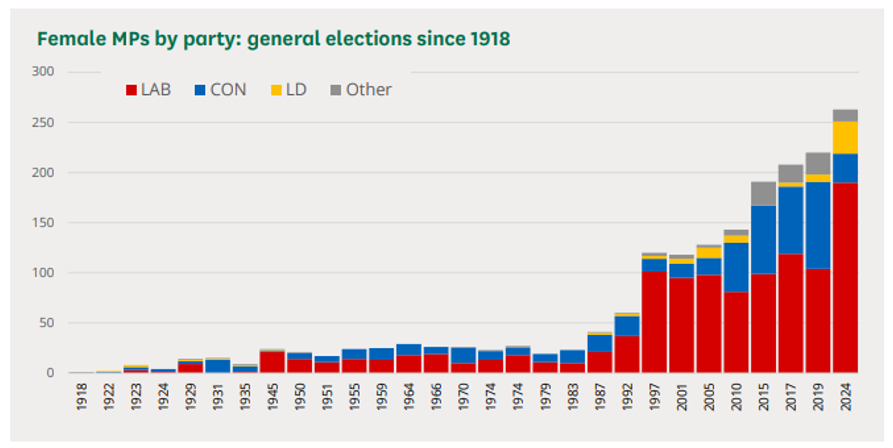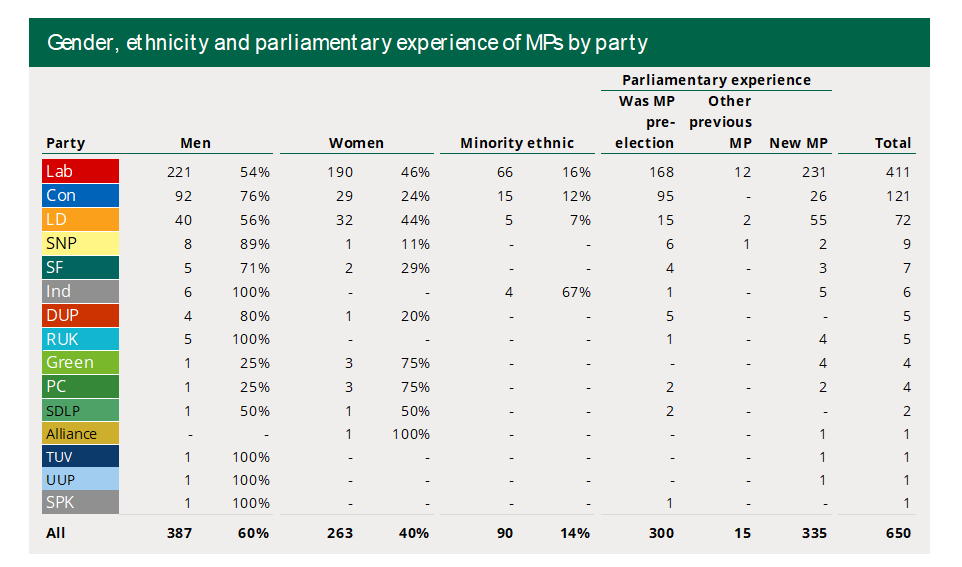What do we know about the 2024 cohort of MPs?
5 min read
Richard Cracknell, Elections statistics specialist at the House of Commons Library, delves into the data to reveal some interesting facts about the class of 2024
The result of the 2024 general election is not news anymore: we all know that Labour came out on top, with 63 per cent of the successful candidates. They were followed by the Conservatives, with 19 per cent, and the Liberal Democrats, with 11 per cent.
But political parties aside, how does the 2024 cohort compare with previous elections? This article looks at how much the make-up of those elected in 2024 represents a change from what has gone before. It uses data from several sources to supplement the somewhat sparse official data about MPs.
New MPs
Over half (52 per cent) of those elected in 2024 are brand new to Parliament: in other words, there are 335 people sitting in the House of Commons who have never been an MP before. Fifteen of 2024’s successful candidates have previously been MPs, but not in the 2019–24 Parliament. Combined, these groups represent the highest ever number and proportion of parliamentary newbies: 350 new MPs.
There were 93 more new MPs in 2024 than in 1997, the last time that Labour returned to power after a period in opposition, and 23 more than in 1945, which previously held the record for being the election that returned the highest proportion of new MPs (51 per cent).
Of the 2024 cohort, only one in ten were in Parliament when Labour was last in government, and only 38 current MPs were first elected in 1997 or before. This contrasts with 2010, when the party of government last changed hands. In the 2010 election, more than one in five (137) MPs who were elected had had parliamentary experience under the previous Conservative government (so, prior to 1997).

Age
It can seem like MPs are getting younger. This impression is actually correct, but only just. For general elections between 1979 and 2019, the average age of MPs at the time of election was consistently close to 50. This has fallen to a sprightly 48 years old in 2024, with the average very similar for both men and women. Of course, as the Parliament ages, so do its members, and the average will be back to around 50 in a couple of years.
In the 2024 cohort, there are 20 MPs aged under 30, and 20 MPs aged over 70. This is similar to the 2019 intake but is relatively high compared to elections between 1979 and 2010. In that period, the numbers of MPs under 30 or over 70 rarely exceeded single figures.
Diversity
Claims that the 2024 Parliament is the “most diverse ever” have been widespread since the election. In the absence of official data on the ethnicity of MPs, most of these claims reference the think tank British Future, which has used candidate profiles and public statements to identify ethnicity. According to this analysis, 90 MPs (14 per cent) come from a minority ethnic background: 16 per cent of Labour MPs and 12 per cent of Conservative MPs. While these figures are not verified, if they are accurate the overall number is a historic high.
The first MPs from minority ethnic backgrounds since World War II were elected in 1987, when four MPs from minority ethnic backgrounds (Diane Abbott, Paul Boateng, Bernie Grant and Keith Vaz) were returned to the House of Commons. This number rose slowly to 15 in 2010 and increased to 66 (10 percent of MPs) by 2019.
As well as having a historic level of representation from minority ethnic MPs, 2024 has also seen the election of Wales’ first ever MP from a minority ethnic background, Kanishka Narayan.

Education
According to research by the Sutton Trust, nine out of 10 MPs in the 2024 cohort (90 per cent) are university graduates, and 40 per cent hold a postgraduate qualification. Twenty per cent of MPs hold a degree from Oxford or Cambridge, down from 23 per cent in 2017 and 21 per cent in 2019. A further 34 per cent of MPs went to another Russell Group university. There are more Oxford graduates (77) than Cambridge graduates (47) among the 2024 cohort. The growing number of MPs who are university graduates continues a previous trend. In 1979, around 65 per cent of MPs from the three main parties were graduates; by 1997 it was 70 per cent
The Sutton Trust also found that the proportion of MPs who attended fee-paying secondary schools is at an all-time low, at 24 per cent for MPs from the three main parties. This proportion has fallen over time from around 50 per cent in 1979 and around 30 per cent in 1997.
Sexual orientation
The LGBT+ online newspaper, Pink News, has identified 64 openly LGBT+ MPs in 2024. This is three fewer than the previous high of 67 at the end of the 2019–24 Parliament. Of the current 64 LGBT+ MPs, 50 are Labour, five Conservative, seven Liberal Democrat, one SNP and one Green. 18 of the LGBT+ MPs are women and 46 are men. Of the 64 LGBT+ MPs elected in 2024, 34 are new to Parliament.
17 years ago, former MP Harriet Harman described politics as “not the white male Westminster club it used to be”. The changes she identified did not stop in 2007, and the 2024 general election returned a cohort of MPs that is less “male”, less “pale” and, given the record number of new MPs, less “stale” than ever before.
The House of Commons Library produces impartial, expert briefings on legislation, policy and topical issues. Our team of statisticians has published detailed analysis of the election results, based on verified declarations from each local authority.
Further analysis of the 2024 General Election is available at: https://commonslibrary.parliament.uk/
